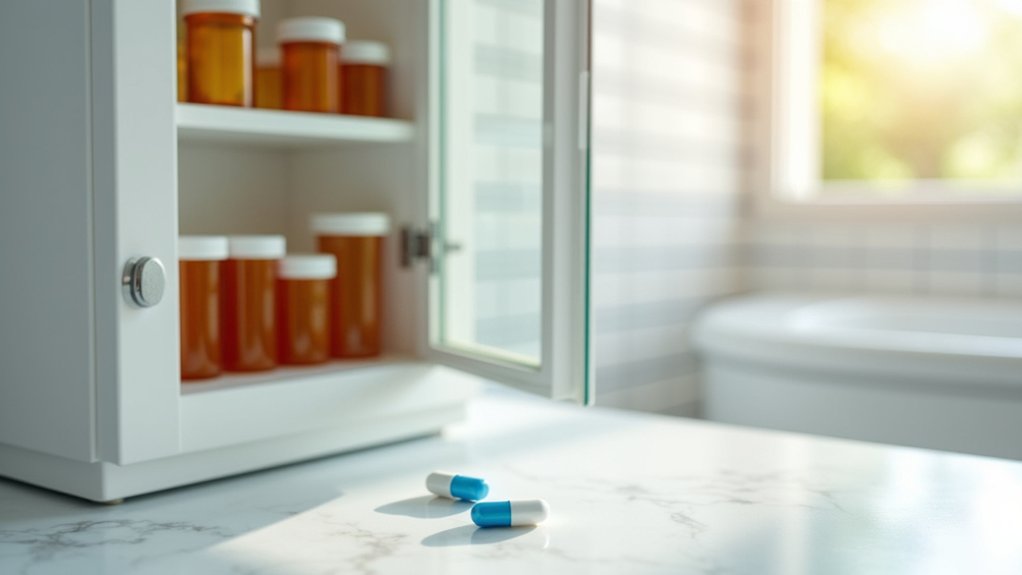Standard antidepressant dosages follow established medical guidelines that prioritize your safety while maximizing treatment effectiveness. SSRIs typically start at lower doses, like fluoxetine (10-20mg), sertraline (50mg), or citalopram (10mg), with careful monitoring during the first 4-6 weeks. Your doctor will adjust doses based on your response and side effects, with older adults often receiving half the standard starting dose. Understanding proper dosing schedules and monitoring protocols guarantees ideal treatment outcomes.
Understanding SSRI Medication Classes

While several classes of antidepressants exist, Selective Serotonin Reuptake Inhibitors (SSRIs) remain the first-line treatment for major depressive disorder. When comparing SSRIs, you’ll find notable differences in half-life duration, ranging from 24 hours for paroxetine to up to 36 hours for sertraline, which affects dosing frequency and adherence patterns. Some SSRIs like vilazodone must be taken with food for effectiveness. SSRIs generally work by increasing the availability of serotonin through reuptake inhibition.
SSRIs come in various formulation types, including immediate-release tablets, extended-release capsules, and oral solutions, allowing for personalized administration. Each medication carries distinct side effect profiles; sertraline commonly causes gastrointestinal issues, while paroxetine may lead to more pronounced sexual dysfunction and weight changes. Special considerations include Brisdelle’s specific indication for menopausal symptoms, sertraline’s relative safety in pregnancy, and paroxetine’s higher withdrawal risk. Many patients may need to try multiple antidepressant options before finding the most effective medication for their symptoms. Understanding these differences helps optimize medication selection for individual patient needs.
Common Starting Doses for New Patients
Starting doses for antidepressants require careful consideration of safety and efficacy, with most medications needing gradual titration to reach therapeutic levels. You’ll find that SSRIs typically begin at lower doses, such as citalopram at 10 mg daily or fluoxetine at 10-20 mg daily, while SNRIs like duloxetine start at 20 mg in the morning. Your provider should monitor your response during the first 4-6 weeks of treatment, adjusting the dose as needed while watching for potential side effects. Primary care professionals can access treatment algorithms to help guide appropriate medication selection and dosing. Studies show that 70 to 80 percent of patients with major depressive disorder can achieve significant symptom reduction when following appropriate treatment plans. For older adults, doctors typically prescribe half the dose compared to standard adult starting amounts to minimize adverse effects.
Initial Dosing Safety Guidelines
When initiating antidepressant therapy, SSRIs typically serve as first-line agents with established starting doses: fluoxetine at 20 mg daily, sertraline at 50 mg daily, and citalopram at 20 mg daily. Initial dosing protocols require special consideration for specific populations and conditions. Some patients may need to wait up to one month before experiencing the full therapeutic effects of fluoxetine.
| Population | Safety Consideration | Starting Dose |
|---|---|---|
| Elderly | Reduced metabolism | 10 mg daily |
| Hepatic Impairment | Lower clearance | 10 mg daily |
| Panic Disorder | Sensitivity | 10 mg daily |
You’ll need to take these medications in the morning to maintain consistent plasma levels and minimize sleep disruption. For doses above 20 mg, your provider may recommend splitting the dose between morning and noon. Patient safety considerations include gradual dose increases and careful monitoring during the first few weeks of treatment, particularly with SNRIs like duloxetine, which requires systematic tapering when discontinuing.
Medication Adjustment Timelines
For most antidepressant medications, therapeutic benefits emerge gradually through careful dose adjustments over several weeks. Your healthcare provider will typically start you on a lower dose and adjust it based on your response and tolerance. Treatment adherence is essential during this adjustment period.
SSRIs follow specific timelines: citalopram and escitalopram are usually adjusted after 1-3 weeks, while sertraline and fluoxetine may be modified weekly. SNRIs like duloxetine require longer intervals, with adjustments every four weeks up to 60mg daily. Patient education about these timelines helps set realistic expectations. TCAs should be started at 25-50 mg daily and increased gradually to minimize side effects.
For older adults, medications like sertraline and escitalopram start at lower doses with more gradual increases. Your doctor will monitor your progress using standardized assessments like PHQ-9 scores to guide dosage modifications throughout your treatment journey.
Safe Medication Adjustment Schedules

Your antidepressant dose adjustments must follow a careful schedule, with medications like sertraline requiring weekly increases while escitalopram needs three-week intervals between changes. You’ll need to maintain each dose level for the prescribed duration to properly assess effectiveness and monitor for side effects before considering any increases. If you’re taking citalopram, you must stay within the 40mg maximum daily limit due to cardiac risks, while other medications like sertraline can safely reach doses up to 200mg daily when clinically indicated. Studies show that half of responders may need up to eight weeks at a given dose level to show improvement in their depression symptoms. Finding the right medication and dosage often requires trial and error as effectiveness can vary significantly between individuals.
Gradual Dose Increase Rules
Safe medication adjustments require strict adherence to established timing protocols and dose increment guidelines. You’ll need to maintain your initial dose for 6-8 weeks before considering any changes, allowing proper assessment of effectiveness. When implementing dose escalation, don’t increase by more than 25-50% of your current dose during each adjustment phase. After achieving symptom relief, continue for six months to ensure stable recovery. Your doctor will monitor withdrawal symptoms if dose adjustments are needed during the tapering process.
Your doctor will follow specific titration strategies, starting with the lowest available dose and increasing it at 2-4 week intervals. For sustained-release medications, you’ll benefit from more predictable absorption rates. It’s essential to maintain each new dose level for 4-6 weeks before evaluating your response. If you experience side effects, your doctor will halt further increases and may adjust the dosage accordingly. Always stay within licensed maximum dose limits, such as 40mg daily for citalopram.
Monitoring Your Medication Changes
Successful medication management requires thorough monitoring across multiple health parameters. You’ll need regular blood pressure checks, especially if you’re taking SNRIs or tricyclic antidepressants. Your healthcare provider will monitor your cardiovascular function, particularly if you have pre-existing heart conditions or are taking medications that can affect QTc intervals. Patient experience reports provide valuable insights into medication effectiveness and side effects.
If you have liver concerns or take hepatotoxic antidepressants, you’ll undergo routine liver function tests. Medication adherence monitoring involves maintaining your prescribed regimen for at least 12 weeks during acute treatment, followed by a 6-month continuation phase. Your provider will use various monitoring techniques to track your progress and adjust dosages accordingly. When discontinuing medications, they’ll watch for withdrawal symptoms using the FINISH criteria and implement a careful tapering schedule to prevent discontinuation syndrome.
Maximum Daily Dosage Limits
Maximum daily dosage limits for antidepressants vary considerably based on the specific medication and condition being treated. Understanding these dosage variations is essential for both safety and effectiveness, with special pediatric considerations for medications like fluoxetine, which has specific ranges for children over 7 years old. Initial dosages typically start at 10 mg once daily for pediatric patients with major depressive disorder and OCD.
- Fluoxetine’s maximum daily dose is 80 mg for adults, though doses over 60 mg don’t show additional benefits. For panic disorder, you’ll typically receive up to 60 mg daily.
- Trazodone treatment for depression can reach 400 mg daily, often split into multiple doses, though lower doses of 25-100 mg are common for off-label insomnia treatment. For older adults aged 65 and above, doctors typically prescribe lower starting doses of 25-50 mg.
- Duloxetine maxes out at 120 mg daily for depression, but for conditions like fibromyalgia, you’ll likely stay at 60 mg daily since higher doses don’t provide extra benefits.
Key Safety Considerations for Different Age Groups

When prescribing antidepressants, different age groups require distinct safety protocols and monitoring strategies to optimize treatment outcomes.
Age-specific guidelines emphasize that children and adolescents need close monitoring for suicidal thinking, especially during initial treatment months. You’ll find fluoxetine is the preferred choice for youth, with lower starting doses to minimize behavioral activation risks. Combining medication with talk therapy often produces the best results. For young adults (18-39), SSRIs remain first-line treatments, though careful tapering is essential when discontinuing. Adults over 60 require additional safety protocols due to complex drug interactions and altered metabolism. Your clinician will screen for comorbidities and adjust dosages accordingly. Across all age groups, you’ll need regular assessment of activation symptoms, potential drug interactions, and treatment response. Special attention to these protocols helps guarantee safe, effective antidepressant therapy.
Managing Side Effects During Treatment
Managing antidepressant side effects requires a systematic approach through consistent medication administration and lifestyle modifications. You’ll need to take medications with food and water at consistent times, while avoiding stimulants that could interfere with their effectiveness. Side effect management often improves when you maintain proper timing and follow prescribed dosages.
- Practice dietary adjustments like eating smaller, frequent meals to minimize nausea and keeping hydrated with water to reduce dizziness
- Implement lifestyle modifications such as light physical activity to combat fatigue and maintaining a regular sleep schedule
- Monitor and track your symptoms, giving your body 2-4 weeks to adapt before discussing changes with your healthcare provider
Remember to report persistent symptoms promptly and seek immediate medical attention for severe reactions like allergic responses or serotonin syndrome.
Long-Term Medication Success Strategies
Successful long-term antidepressant treatment depends on implementing thorough medication management strategies that align with your daily routines. To enhance medication adherence, you’ll benefit from using pill organizers, electronic reminders, and pre-filled blister packs that simplify your dosing schedule.
Your healthcare team can create personalized intervention plans that address your specific needs and barriers. Patient engagement improves when you participate in collaborative treatment planning and receive regular education about your medication’s benefits. Consider enrolling in programs like TIP, which helps overcome early treatment challenges through targeted support.
Take advantage of available resources such as electronic monitoring systems, pharmacist consultations, and scheduled medication reviews. If cost is a barrier, discuss options with your provider about reduced copays or medication access programs through your insurance or employer.
Combining Medications With Other Therapies
Building on your medication management plan, combining antidepressants with additional therapeutic approaches offers improved treatment outcomes. Research shows that combination strategies, particularly integrating psychological therapies with medication, lead to better results compared to single-treatment approaches. You’ll find that these integrated approaches are especially effective for moderate to severe depression cases.
- Cognitive-behavioral therapy (CBT) paired with SSRIs or SNRIs greatly improves treatment success rates, particularly in severe cases
- Your doctor may recommend combining different antidepressants, such as adding mirtazapine or bupropion to your current SSRI/SNRI treatment
- If you’re under 18, psychological integration is mandatory alongside any antidepressant medication
Regular monitoring and dose adjustments guarantee you’re receiving ideal benefits from your combined treatment plan while maintaining safety and effectiveness. Your healthcare provider will help determine the most appropriate combination strategy based on your specific needs.
Monitoring Progress and Treatment Goals
Regular monitoring of your depression treatment involves four key components: validated symptom scales, side effect assessments, medication adherence checks, and functional status evaluations. Your doctor will use tools like QIDS-C16 to track your progress systematically.
| Treatment Phase | Duration | Key Milestones |
|---|---|---|
| Acute | 12 weeks | Week 6 evaluation |
| Continuation | 4-9 months | Remission check |
| Maintenance | 9+ months | Quarterly visits |
| Tapering | Variable | Withdrawal monitoring |
You’ll need consistent symptom tracking throughout each phase. At week 6, your doctor will assess if you’ve achieved remission (QIDS-C16 <5), partial response (6-8), or remain symptomatic (>9). Treatment adherence is essential; missing doses can affect your progress evaluation. Your provider will adjust your treatment plan based on these assessments, potentially including dose changes or augmentation strategies if needed.
Frequently Asked Questions
How Long After Stopping Antidepressants Can I Drink Alcohol?
You’ll need to consult your doctor for personalized guidance, as alcohol interactions vary greatly based on your specific antidepressant and individual factors. Your recovery timeline depends on the medication’s half-life, metabolism, and whether you’re experiencing withdrawal symptoms. Don’t drink during the withdrawal phase, which can last several weeks. You should wait until your doctor confirms the medication has cleared your system and you’re emotionally stable before consuming alcohol.
Can I Take My Antidepressant Medication With Grapefruit Juice?
You shouldn’t take your antidepressants with grapefruit juice due to potentially dangerous interactions. Grapefruit can inhibit enzymes that break down medications, leading to increased medication absorption in your body. This interaction can last up to 24 hours and may cause heightened drug levels, increasing your risk of side effects. It’s best to avoid grapefruit completely while taking antidepressants like Seroquel, Latuda, or Zoloft. Consult your healthcare provider for specific guidance.
Will My Sex Drive Return to Normal After Stopping These Medications?
Most people will see their sex drive improve after stopping antidepressants, but recovery timeframes vary. While medication side effects typically resolve within weeks of discontinuation, your individual outcome depends on several factors, including how long you’ve taken the medication and your underlying depression severity. Hormonal changes may take time to rebalance. There’s no guarantee of complete restoration; some people experience lasting changes. Working with your healthcare provider during discontinuation is essential for ideal recovery.
Should I Take Antidepressants With Food or on an Empty Stomach?
Generally, you’ll want to take antidepressants with food to minimize nausea and digestive side effects, unless your healthcare provider specifically instructs otherwise. Food interactions and dosage timing can vary between different antidepressants; some medications may have specific requirements. If you’re experiencing stomach upset, try taking your medication with a small meal. However, always consult your healthcare provider for personalized guidance, as individual medications may have unique requirements.
Can I Switch Between Different Brands of the Same Antidepressant Medication?
While you can switch between different brands of the same antidepressant, you should always do so under your healthcare provider’s supervision. Brand differences, though slight, can affect medication effectiveness due to varying inactive ingredients and absorption rates. You’ll need to monitor your symptoms carefully after any switch. If you’re stable on your current brand, it’s often best to stick with it unless there’s a compelling reason to change.






